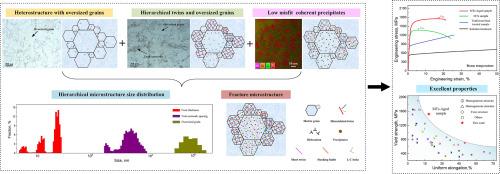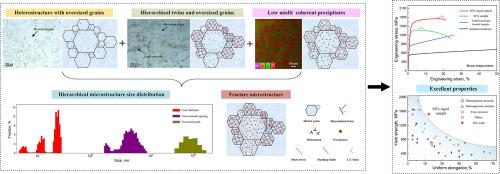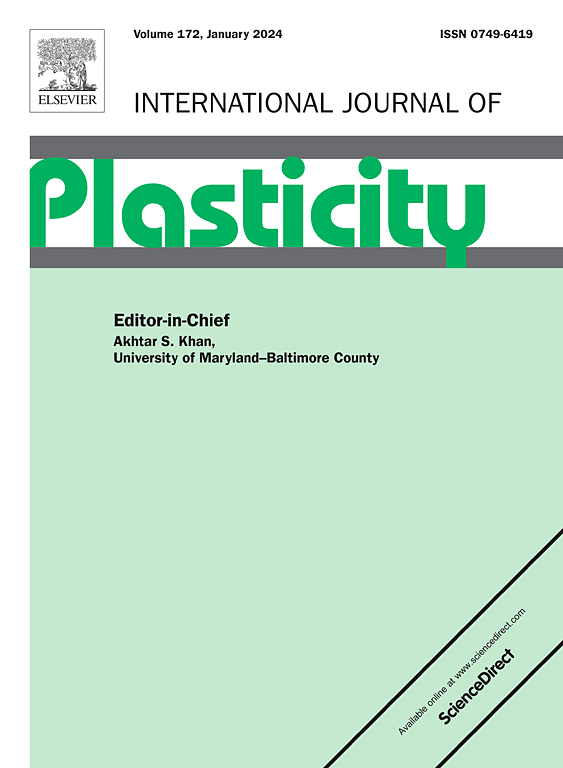通过定制双峰晶粒结构、分层孪晶和相干纳米沉淀物,克服镍基合金的强度和延展性权衡问题
IF 9.4
1区 材料科学
Q1 ENGINEERING, MECHANICAL
引用次数: 0
摘要
长期以来,强度与电导率之间的权衡一直是材料科学领域的重大挑战,限制了众多结构材料的潜在应用。通过调整微结构来激活多种强化/变形机制的协同效应,从而提高材料的性能至关重要。在本研究中,我们介绍了一种在镍基合金中开发多尺度异质结构的新策略,其特点是双峰晶粒分布,小晶粒含有高密度分层孪晶(三阶),大晶粒则没有孪晶。微观结构异质性和特意的孪晶分布相结合,使合金在不同区域表现出特定的强化和变形机制,增强了基体并有效地分散了应力和应变。同时,晶格失配度极低(0.193%)的纳米级 L12 沉淀分布在所有晶粒中,减少了位错运动引起的弹性应变积累,从而防止了界面处裂纹的产生。这种结构对位错的独特阻碍和容纳,在不牺牲延展性的情况下显著提高了强度,屈服强度高达 1498.6 兆帕,均匀伸长率为 18%。在拉伸变形过程中,具有孪晶的小晶粒和超大晶粒吸收和约束位错的能力各不相同。分层孪晶有利于与多个方向的位错相互作用。各种变形机制,包括高密度的微小堆叠断层、Lomer-Cottrell锁和短孪晶都被激活,尤其是在超大晶粒中,它们促进了位错的增殖和积累,从而促成了高应变硬化能力和优异的延展性。这项研究为通过管理多尺度微结构异质性来设计超强韧性合金提供了新的范例和见解。本文章由计算机程序翻译,如有差异,请以英文原文为准。


Overcoming the strength and ductility trade-off in Ni-based alloy through tailoring of bimodal grain structures, hierarchical twins and coherent nanoprecipitates
The longstanding strength-ductility trade-off has posed a significant challenge in materials science, limiting the potential applications of numerous structural materials. It is crucial to improve performance by adjusting microstructures to activate a synergistic effect of multiple strengthening/deformation mechanisms. In this study, we introduce a novel strategy to develop a multi-scale heterogeneous structure in a Ni-based alloy, characterized by a bimodal grain distribution with small grains containing high-density hierarchical twins (third-order), oversized grains devoid of twins. The combination of microstructural heterogeneity and deliberate twin distribution enables the alloy to exhibit specific strengthening and deformation mechanisms in different regions, enhancing the matrix and effectively distributing the stress and strain. Simultaneously, nanoscale L12 precipitates with an extremely low lattice mismatch (0.193 %) distributed across all grains, reducing the accumulation of elastic strain caused by dislocation movement and thereby preventing crack initiation at interfaces. The unique hindrance and accommodation of dislocations by this structure significantly enhance strength without sacrificing ductility, achieving a yield strength as high as 1498.6 MPa and a uniform elongation of 18 %. During tensile deformation, small grains with twins and oversized grains exhibit different abilities to absorb and constrain dislocations. Hierarchical twins facilitate interactions with dislocations in multiple directions. Various deformation mechanisms, including a high density of tiny stacking faults, Lomer-Cottrell locks, and short twins, are activated, particularly in the oversized grains, which promote increased dislocation multiplication and accumulation, contributing to the high strain hardening ability and excellent ductility. This study offers a novel paradigm and insights for designing ultra-strong and ductile alloys by managing multi-scale microstructural heterogeneities.
求助全文
通过发布文献求助,成功后即可免费获取论文全文。
去求助
来源期刊

International Journal of Plasticity
工程技术-材料科学:综合
CiteScore
15.30
自引率
26.50%
发文量
256
审稿时长
46 days
期刊介绍:
International Journal of Plasticity aims to present original research encompassing all facets of plastic deformation, damage, and fracture behavior in both isotropic and anisotropic solids. This includes exploring the thermodynamics of plasticity and fracture, continuum theory, and macroscopic as well as microscopic phenomena.
Topics of interest span the plastic behavior of single crystals and polycrystalline metals, ceramics, rocks, soils, composites, nanocrystalline and microelectronics materials, shape memory alloys, ferroelectric ceramics, thin films, and polymers. Additionally, the journal covers plasticity aspects of failure and fracture mechanics. Contributions involving significant experimental, numerical, or theoretical advancements that enhance the understanding of the plastic behavior of solids are particularly valued. Papers addressing the modeling of finite nonlinear elastic deformation, bearing similarities to the modeling of plastic deformation, are also welcomed.
 求助内容:
求助内容: 应助结果提醒方式:
应助结果提醒方式:


